初中英语时态语态教案终极整理版
- 格式:doc
- 大小:89.03 KB
- 文档页数:13
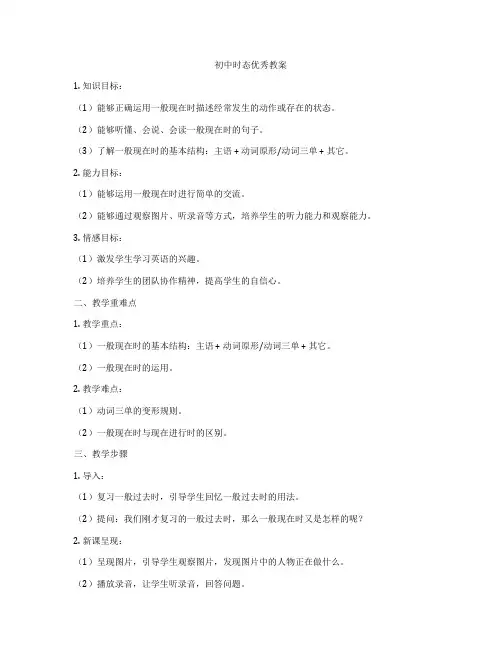
初中时态优秀教案1. 知识目标:(1)能够正确运用一般现在时描述经常发生的动作或存在的状态。
(2)能够听懂、会说、会读一般现在时的句子。
(3)了解一般现在时的基本结构:主语 + 动词原形/动词三单 + 其它。
2. 能力目标:(1)能够运用一般现在时进行简单的交流。
(2)能够通过观察图片、听录音等方式,培养学生的听力能力和观察能力。
3. 情感目标:(1)激发学生学习英语的兴趣。
(2)培养学生的团队协作精神,提高学生的自信心。
二、教学重难点1. 教学重点:(1)一般现在时的基本结构:主语 + 动词原形/动词三单 + 其它。
(2)一般现在时的运用。
2. 教学难点:(1)动词三单的变形规则。
(2)一般现在时与现在进行时的区别。
三、教学步骤1. 导入:(1)复习一般过去时,引导学生回忆一般过去时的用法。
(2)提问:我们刚才复习的一般过去时,那么一般现在时又是怎样的呢?2. 新课呈现:(1)呈现图片,引导学生观察图片,发现图片中的人物正在做什么。
(2)播放录音,让学生听录音,回答问题。
3. 讲解:(1)讲解一般现在时的基本结构:主语 + 动词原形/动词三单 + 其它。
(2)讲解动词三单的变形规则。
4. 练习:(1)分组练习,让学生相互问答,运用一般现在时。
(2)完成练习题,巩固所学知识。
5. 课堂小结:(1)回顾本节课所学内容,总结一般现在时的用法。
(2)强调一般现在时与现在进行时的区别。
6. 作业布置:(1)抄写一般现在时的句子,巩固动词三单的变形。
(2)运用一般现在时,写一段小故事。
四、教学反思在教学过程中,要注意观察学生的反应,根据学生的实际情况调整教学节奏和难度。
在练习环节,要多给学生机会开口说英语,培养他们的口语表达能力。
同时,要关注学生的学习兴趣,尽量让课堂变得生动有趣,提高学生的学习积极性。
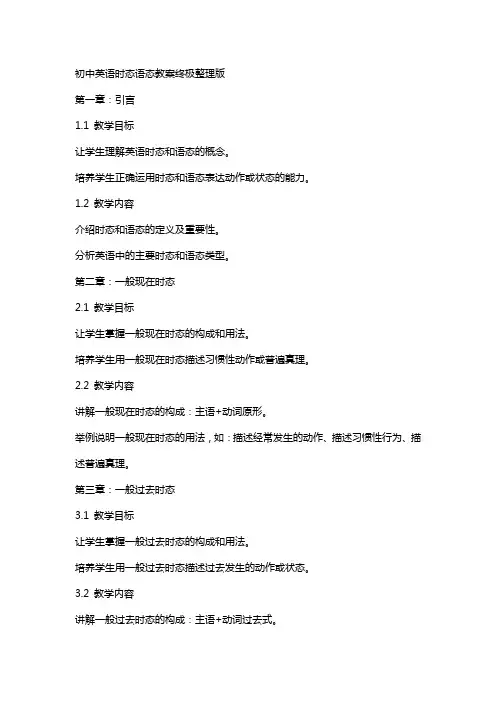
初中英语时态语态教案终极整理版第一章:引言1.1 教学目标让学生理解英语时态和语态的概念。
培养学生正确运用时态和语态表达动作或状态的能力。
1.2 教学内容介绍时态和语态的定义及重要性。
分析英语中的主要时态和语态类型。
第二章:一般现在时态2.1 教学目标让学生掌握一般现在时态的构成和用法。
培养学生用一般现在时态描述习惯性动作或普遍真理。
2.2 教学内容讲解一般现在时态的构成:主语+动词原形。
举例说明一般现在时态的用法,如:描述经常发生的动作、描述习惯性行为、描述普遍真理。
第三章:一般过去时态3.1 教学目标让学生掌握一般过去时态的构成和用法。
培养学生用一般过去时态描述过去发生的动作或状态。
3.2 教学内容讲解一般过去时态的构成:主语+动词过去式。
举例说明一般过去时态的用法,如:描述过去发生的动作、描述过去的状态、描述过去的事实。
第四章:一般将来时态4.1 教学目标让学生掌握一般将来时态的构成和用法。
培养学生用一般将来时态描述将来发生的动作或计划。
4.2 教学内容讲解一般将来时态的构成:主语+will+动词原形。
举例说明一般将来时态的用法,如:描述将来发生的动作、描述未来的计划或打算、表示预测或祝愿。
第五章:现在进行时态5.1 教学目标让学生掌握现在进行时态的构成和用法。
培养学生用现在进行时态描述正在进行的动作或存在的状态。
5.2 教学内容讲解现在进行时态的构成:主语+am/is/are+动词ing形式。
举例说明现在进行时态的用法,如:描述正在进行的动作、描述存在的状态、描述近期计划或打算。
第六章:过去进行时态6.1 教学目标让学生掌握过去进行时态的构成和用法。
培养学生用过去进行时态描述过去某个时刻正在进行的动作。
6.2 教学内容讲解过去进行时态的构成:主语+was/were+动词ing形式。
举例说明过去进行时态的用法,如:描述过去某个时刻正在进行的动作、描述过去某个时刻存在的状态。
第七章:现在完成时态7.1 教学目标让学生掌握现在完成时态的构成和用法。
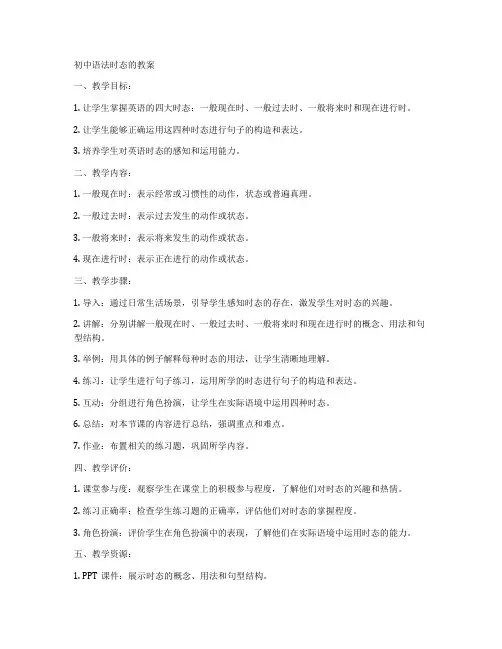
初中语法时态的教案一、教学目标:1. 让学生掌握英语的四大时态:一般现在时、一般过去时、一般将来时和现在进行时。
2. 让学生能够正确运用这四种时态进行句子的构造和表达。
3. 培养学生对英语时态的感知和运用能力。
二、教学内容:1. 一般现在时:表示经常或习惯性的动作,状态或普遍真理。
2. 一般过去时:表示过去发生的动作或状态。
3. 一般将来时:表示将来发生的动作或状态。
4. 现在进行时:表示正在进行的动作或状态。
三、教学步骤:1. 导入:通过日常生活场景,引导学生感知时态的存在,激发学生对时态的兴趣。
2. 讲解:分别讲解一般现在时、一般过去时、一般将来时和现在进行时的概念、用法和句型结构。
3. 举例:用具体的例子解释每种时态的用法,让学生清晰地理解。
4. 练习:让学生进行句子练习,运用所学的时态进行句子的构造和表达。
5. 互动:分组进行角色扮演,让学生在实际语境中运用四种时态。
6. 总结:对本节课的内容进行总结,强调重点和难点。
7. 作业:布置相关的练习题,巩固所学内容。
四、教学评价:1. 课堂参与度:观察学生在课堂上的积极参与程度,了解他们对时态的兴趣和热情。
2. 练习正确率:检查学生练习题的正确率,评估他们对时态的掌握程度。
3. 角色扮演:评价学生在角色扮演中的表现,了解他们在实际语境中运用时态的能力。
五、教学资源:1. PPT课件:展示时态的概念、用法和句型结构。
2. 练习题:提供各种类型的练习题,巩固所学内容。
3. 角色扮演:准备相关的情景,让学生进行实际操作。
六、教学建议:1. 注重学生的实际操作,让他们在实践中掌握时态的用法。
2. 多用多媒体手段,如PPT、视频等,丰富教学手段,提高学生的学习兴趣。
3. 针对不同学生的学习程度,进行分层教学,确保每个学生都能跟上教学进度。
4. 鼓励学生进行合作学习,互相交流,提高他们的语言运用能力。
5. 定期进行教学评价,了解学生的学习情况,及时调整教学方法和策略。
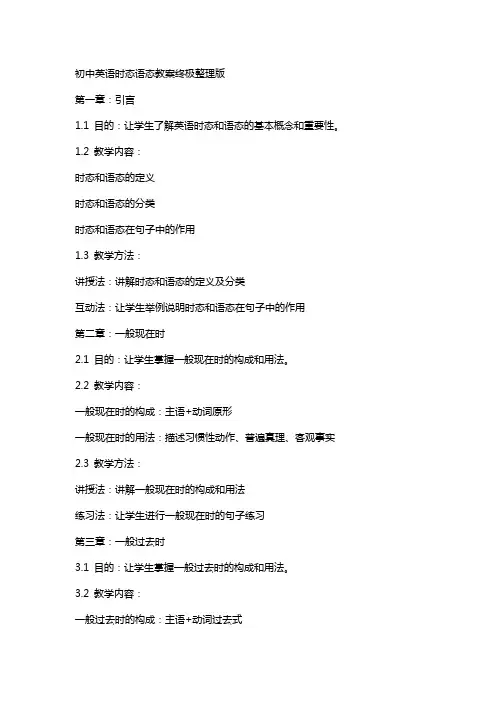
初中英语时态语态教案终极整理版第一章:引言1.1 目的:让学生了解英语时态和语态的基本概念和重要性。
1.2 教学内容:时态和语态的定义时态和语态的分类时态和语态在句子中的作用1.3 教学方法:讲授法:讲解时态和语态的定义及分类互动法:让学生举例说明时态和语态在句子中的作用第二章:一般现在时2.1 目的:让学生掌握一般现在时的构成和用法。
2.2 教学内容:一般现在时的构成:主语+动词原形一般现在时的用法:描述习惯性动作、普遍真理、客观事实2.3 教学方法:讲授法:讲解一般现在时的构成和用法练习法:让学生进行一般现在时的句子练习第三章:一般过去时3.1 目的:让学生掌握一般过去时的构成和用法。
3.2 教学内容:一般过去时的构成:主语+动词过去式一般过去时的用法:描述过去发生的动作或状态3.3 教学方法:讲授法:讲解一般过去时的构成和用法练习法:让学生进行一般过去时的句子练习第四章:一般将来时4.1 目的:让学生掌握一般将来时的构成和用法。
4.2 教学内容:一般将来时的构成:主语+will+动词原形一般将来时的用法:描述将来发生的动作或计划4.3 教学方法:讲授法:讲解一般将来时的构成和用法练习法:让学生进行一般将来时的句子练习第五章:现在进行时5.1 目的:让学生掌握现在进行时的构成和用法。
5.2 教学内容:现在进行时的构成:主语+am/is/are+动词ing 现在进行时的用法:描述正在进行的动作或状态5.3 教学方法:讲授法:讲解现在进行时的构成和用法练习法:让学生进行现在进行时的句子练习第六章:现在完成时6.1 目的:让学生掌握现在完成时的构成和用法。
6.2 教学内容:现在完成时的构成:主语+have/has+过去分词现在完成时的用法:描述过去发生的动作对现在造成的影响或结果6.3 教学方法:讲授法:讲解现在完成时的构成和用法练习法:让学生进行现在完成时的句子练习第七章:过去进行时7.1 目的:让学生掌握过去进行时的构成和用法。
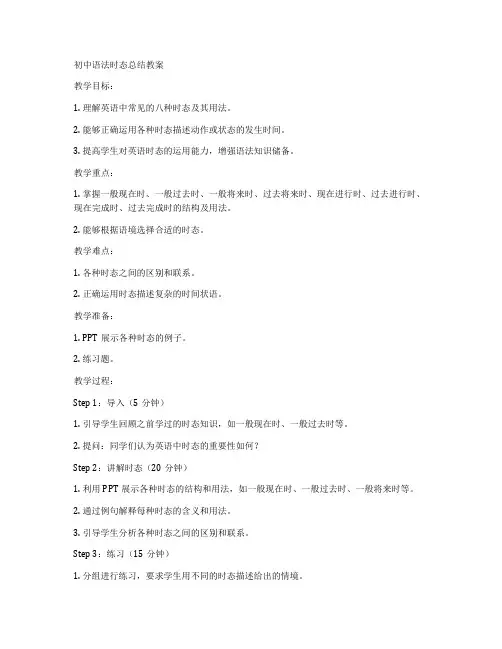
初中语法时态总结教案教学目标:1. 理解英语中常见的八种时态及其用法。
2. 能够正确运用各种时态描述动作或状态的发生时间。
3. 提高学生对英语时态的运用能力,增强语法知识储备。
教学重点:1. 掌握一般现在时、一般过去时、一般将来时、过去将来时、现在进行时、过去进行时、现在完成时、过去完成时的结构及用法。
2. 能够根据语境选择合适的时态。
教学难点:1. 各种时态之间的区别和联系。
2. 正确运用时态描述复杂的时间状语。
教学准备:1. PPT展示各种时态的例子。
2. 练习题。
教学过程:Step 1:导入(5分钟)1. 引导学生回顾之前学过的时态知识,如一般现在时、一般过去时等。
2. 提问:同学们认为英语中时态的重要性如何?Step 2:讲解时态(20分钟)1. 利用PPT展示各种时态的结构和用法,如一般现在时、一般过去时、一般将来时等。
2. 通过例句解释每种时态的含义和用法。
3. 引导学生分析各种时态之间的区别和联系。
Step 3:练习(15分钟)1. 分组进行练习,要求学生用不同的时态描述给出的情境。
2. 教师选取部分学生的答案进行讲解和分析。
Step 4:课堂小结(5分钟)1. 教师总结本节课所学内容,强调各种时态的用法和重要性。
2. 提醒学生要注意时态的正确运用。
Step 5:课后作业(10分钟)1. 要求学生完成课后练习题,巩固所学时态知识。
2. 鼓励学生多进行时态练习,提高运用能力。
教学反思:本节课通过讲解和练习,使学生对英语中常见的八种时态有了更深入的了解。
在教学过程中,要注意引导学生分析各种时态之间的区别和联系,提高他们的语法素养。
同时,通过课后作业的布置,让学生巩固所学知识,提高运用能力。
总之,本节课旨在帮助学生掌握英语时态知识,提高他们的语法水平。
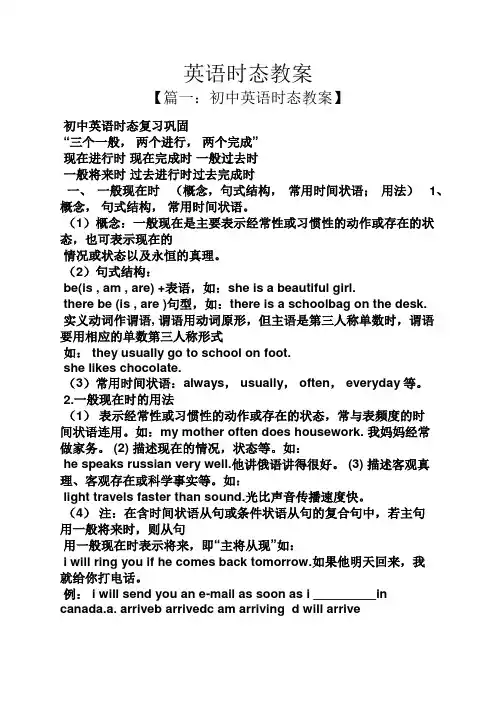
英语时态教案【篇一:初中英语时态教案】初中英语时态复习巩固“三个一般,两个进行,两个完成”现在进行时现在完成时一般过去时一般将来时过去进行时过去完成时一、一般现在时(概念,句式结构,常用时间状语;用法)1、概念,句式结构,常用时间状语。
(1)概念:一般现在是主要表示经常性或习惯性的动作或存在的状态,也可表示现在的情况或状态以及永恒的真理。
(2)句式结构:be(is , am , are) +表语,如:she is a beautiful girl.there be (is , are )句型,如:there is a schoolbag on the desk.实义动词作谓语, 谓语用动词原形,但主语是第三人称单数时,谓语要用相应的单数第三人称形式如: they usually go to school on foot.she likes chocolate.(3)常用时间状语:always, usually, often, everyday等。
2.一般现在时的用法(1)表示经常性或习惯性的动作或存在的状态,常与表频度的时间状语连用。
如:my mother often does housework. 我妈妈经常做家务。
(2) 描述现在的情况,状态等。
如:he speaks russian very well.他讲俄语讲得很好。
(3) 描述客观真理、客观存在或科学事实等。
如:light travels faster than sound.光比声音传播速度快。
(4)注:在含时间状语从句或条件状语从句的复合句中,若主句用一般将来时,则从句用一般现在时表示将来,即“主将从现”如:i will ring you if he comes back tomorrow.如果他明天回来,我就给你打电话。
例: i will send you an e-mail as soon as i _________in canada.a. arriveb arrivedc am arriving d will arrive(5) 在以here , there开头的句子中常用一般现在时代替进行时。
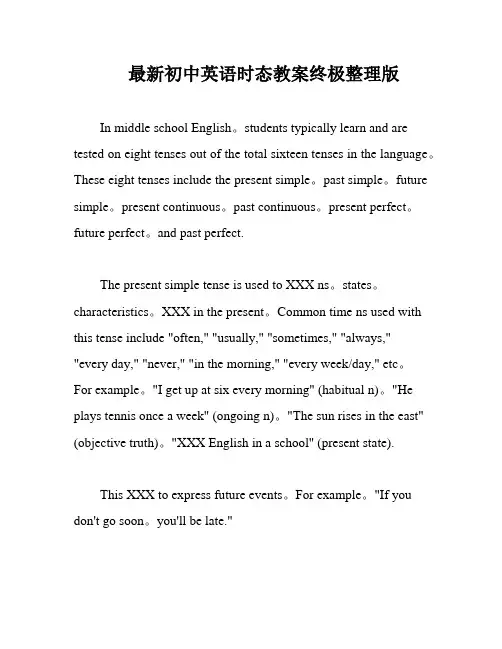
最新初中英语时态教案终极整理版In middle school English。
students typically learn and are tested on eight tenses out of the total sixteen tenses in the language。
These eight tenses include the present simple。
past simple。
future simple。
present continuous。
past continuous。
present perfect。
future perfect。
and past perfect.The present simple tense is used to XXX ns。
states。
characteristics。
XXX in the present。
Common time ns used with this tense include "often," "usually," "sometimes," "always," "every day," "never," "in the morning," "every week/day," etc。
For example。
"I get up at six every morning" (habitual n)。
"He plays tennis once a week" (ongoing n)。
"The sun rises in the east" (objective truth)。
"XXX English in a school" (present state).This XXX to express future events。
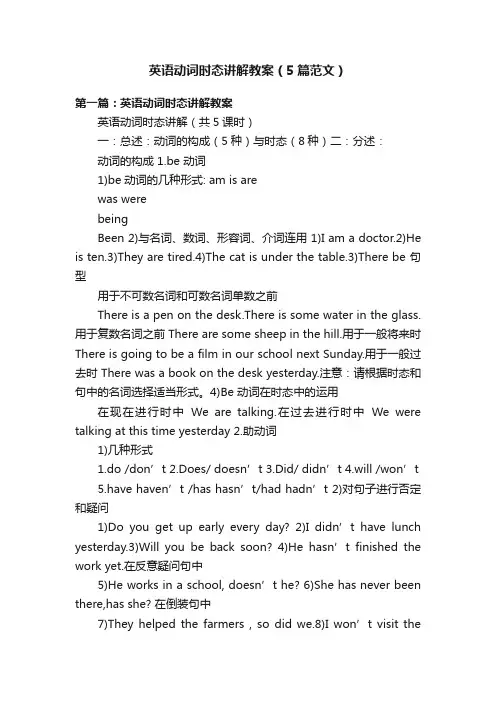
英语动词时态讲解教案(5篇范文)第一篇:英语动词时态讲解教案英语动词时态讲解(共5课时)一:总述:动词的构成(5种)与时态(8种)二:分述:动词的构成 1.be 动词1)be动词的几种形式: am is arewas werebeingBeen 2)与名词、数词、形容词、介词连用 1)I am a doctor.2)He is ten.3)They are tired.4)The cat is under the table.3)There be 句型用于不可数名词和可数名词单数之前There is a pen on the desk.There is some water in the glass.用于复数名词之前 There are some sheep in the hill.用于一般将来时There is going to be a film in our school next Sunday.用于一般过去时 There was a book on the desk yesterday.注意:请根据时态和句中的名词选择适当形式。
4)Be 动词在时态中的运用在现在进行时中We are talking.在过去进行时中We were talking at this time yesterday 2.助动词1)几种形式1.do /don’t2.Does/ doesn’t3.Did/ didn’t4.will /won’t5.have haven’t /has hasn’t/had hadn’t 2)对句子进行否定和疑问1)Do you get up early every day? 2)I didn’t have lunch yesterday.3)Will you be back soon? 4)He hasn’t finished the work yet.在反意疑问句中5)He works in a school, doesn’t he? 6)She has never been there,has she? 在倒装句中7)They helped the farmers , so did we.8)I won’t visit thefamous singer,neither will he.3.情态动词共同特点: 情态动词后面跟动词原型,无论否定、疑问、倒装句、或反意疑问句都用情态动词1 只有时态变化,没有人称变化。
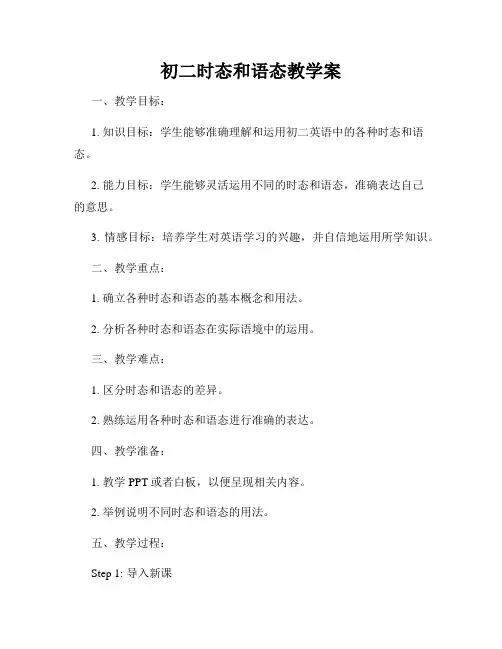
初二时态和语态教学案一、教学目标:1. 知识目标:学生能够准确理解和运用初二英语中的各种时态和语态。
2. 能力目标:学生能够灵活运用不同的时态和语态,准确表达自己的意思。
3. 情感目标:培养学生对英语学习的兴趣,并自信地运用所学知识。
二、教学重点:1. 确立各种时态和语态的基本概念和用法。
2. 分析各种时态和语态在实际语境中的运用。
三、教学难点:1. 区分时态和语态的差异。
2. 熟练运用各种时态和语态进行准确的表达。
四、教学准备:1. 教学PPT或者白板,以便呈现相关内容。
2. 举例说明不同时态和语态的用法。
五、教学过程:Step 1: 导入新课1. 利用图片或者视频等方式,引起学生对时态和语态的兴趣。
2. 鼓励学生提问并分享自己对时态和语态的理解。
Step 2: 时态概念及用法介绍1. 针对一般现在时态,用法简单明了,并以一些常见的动词和动作词充实语境。
2. 针对一般过去时态,突出过去的时间和动作的完成状态,引导学生在日常生活中运用。
3. 针对一般将来时态,从时态本身延伸到表示未来发生的事情的常用句子,让学生能够灵活运用。
4. 引导学生理解现在进行时、过去进行时的用法,加深对动作进行中的理解。
Step 3: 语态概念及用法介绍1. 简明扼要解释被动语态的构成和用法。
2. 分析被动语态在与主动语态的转换中的作用。
3. 引导学生通过实例理解被动语态的运用,并从中总结被动语态的特点。
Step 4: 练习巩固1. 给予学生一些练习题,包括填空和改写句子。
2. 利用图片等情境,让学生根据提示写出合适的句子,并尽量使用所学的各种时态和语态。
3. 引导学生进行交流,相互修改句子中的时态和语态错误,并进行讨论和分享。
Step 5: 拓展延伸1. 引导学生运用所学时态和语态,展开一段话题性的对话,并进行角色扮演。
2. 鼓励学生使用各种不同的时态和语态,提高他们对英语的思维活跃度和语言表达能力。
3. 针对某些学生的困难与问题,及时给予解答和辅导。
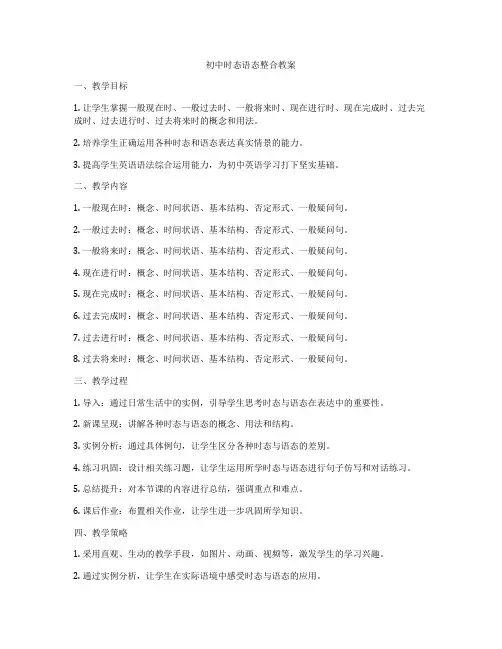
初中时态语态整合教案一、教学目标1. 让学生掌握一般现在时、一般过去时、一般将来时、现在进行时、现在完成时、过去完成时、过去进行时、过去将来时的概念和用法。
2. 培养学生正确运用各种时态和语态表达真实情景的能力。
3. 提高学生英语语法综合运用能力,为初中英语学习打下坚实基础。
二、教学内容1. 一般现在时:概念、时间状语、基本结构、否定形式、一般疑问句。
2. 一般过去时:概念、时间状语、基本结构、否定形式、一般疑问句。
3. 一般将来时:概念、时间状语、基本结构、否定形式、一般疑问句。
4. 现在进行时:概念、时间状语、基本结构、否定形式、一般疑问句。
5. 现在完成时:概念、时间状语、基本结构、否定形式、一般疑问句。
6. 过去完成时:概念、时间状语、基本结构、否定形式、一般疑问句。
7. 过去进行时:概念、时间状语、基本结构、否定形式、一般疑问句。
8. 过去将来时:概念、时间状语、基本结构、否定形式、一般疑问句。
三、教学过程1. 导入:通过日常生活中的实例,引导学生思考时态与语态在表达中的重要性。
2. 新课呈现:讲解各种时态与语态的概念、用法和结构。
3. 实例分析:通过具体例句,让学生区分各种时态与语态的差别。
4. 练习巩固:设计相关练习题,让学生运用所学时态与语态进行句子仿写和对话练习。
5. 总结提升:对本节课的内容进行总结,强调重点和难点。
6. 课后作业:布置相关作业,让学生进一步巩固所学知识。
四、教学策略1. 采用直观、生动的教学手段,如图片、动画、视频等,激发学生的学习兴趣。
2. 通过实例分析,让学生在实际语境中感受时态与语态的应用。
3. 设计丰富的练习题,注重分层教学,使每位学生都能得到有效的训练。
4. 组织小组讨论和互动,鼓励学生主动参与课堂,提高课堂活力。
5. 注重个体差异,给予学生充分的关注和指导,帮助其克服学习困难。
五、教学评价1. 课堂表现:观察学生在课堂上的参与程度、发言情况等。
2. 练习完成情况:检查学生作业、测验等的完成质量。
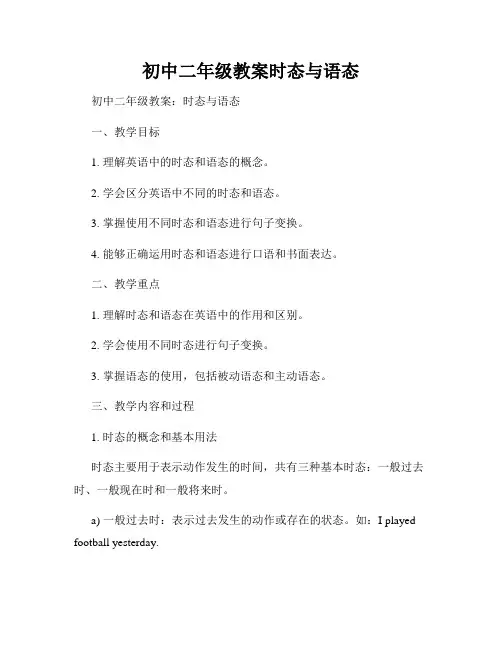
初中二年级教案时态与语态初中二年级教案:时态与语态一、教学目标1. 理解英语中的时态和语态的概念。
2. 学会区分英语中不同的时态和语态。
3. 掌握使用不同时态和语态进行句子变换。
4. 能够正确运用时态和语态进行口语和书面表达。
二、教学重点1. 理解时态和语态在英语中的作用和区别。
2. 学会使用不同时态进行句子变换。
3. 掌握语态的使用,包括被动语态和主动语态。
三、教学内容和过程1. 时态的概念和基本用法时态主要用于表示动作发生的时间,共有三种基本时态:一般过去时、一般现在时和一般将来时。
a) 一般过去时:表示过去发生的动作或存在的状态。
如:I played football yesterday.b) 一般现在时:表示现在常发生的动作、经常性的真理或现在的状态。
如:He drinks milk every day.c) 一般将来时:表示将来发生的动作或存在的状态。
如:They will go to the park tomorrow.2. 时态的变换与练习为了更好地理解和掌握时态,让学生通过练习来进行实践。
a) 过去时变换:练习将一般现在时变为一般过去时。
如:I play football → I played football.b) 现在时变换:练习将一般过去时变为一般现在时。
如:He played football → He plays football.c) 将来时变换:练习将一般现在时变为一般将来时。
如:They play football → They will play football.3. 语态的概念和基本用法语态用于表示句子的主语和谓语动词之间的关系,包括主动语态和被动语态。
a) 主动语态:主语是动作的执行者。
如:I drink milk.(我喝牛奶)b) 被动语态:主语是动作的承受者。
如:Milk is drunk by me.(牛奶被我喝了)4. 语态的变换与练习让学生通过变换句子的语态来加深对语态概念的理解和应用。
初中英语时态和语态复习教案一、教学目标1. 熟练掌握英语的基本时态和语态;2. 能正确运用各种时态和语态进行句子转换;3. 加深对时态和语态的理解,提高英语语言运用能力。
二、教学内容时态和语态的复习和运用三、教学过程1. 导入通过展示一张图片或播放一个视频,引导学生回忆过去发生的事情,并让学生使用过去时描述图片或视频内容。
2. 时态的复习(1)现在时态- 用法:表示现在正在进行的动作或状态。
- 结构:主语 + 动词-ing- 例句:I am studying English now.(2)过去时态- 用法:表示过去发生的动作或状态。
- 结构:主语 + 动词过去式- 例句:He went to the park yesterday.(3)将来时态- 用法:表示将来要发生的动作或状态。
- 结构:主语 + will + 动词原形- 例句:They will have a meeting tomorrow.3. 时态转换练习让学生根据给出的句子,将其改写成其他时态,并解释改变的原因和规则。
例题:(1) They are playing basketball now.转换为过去时态:They were playing basketball yesterday.解释:由于动作是在过去发生的,所以需要将现在时态改为过去时态。
(2) I will go to the supermarket tomorrow.转换为现在进行时:I am going to the supermarket now.解释:虽然动作发生在将来,但是现在正在进行。
4. 语态的复习(1)被动语态- 用法:强调动作的承受者而非执行者。
- 结构:主语 + be + 过去分词(动词-ed)- 例句:The book was written by him.(2)进行时的被动语态- 用法:强调正在进行的被动动作。
- 结构:主语 + be + being + 过去分词(动词-ed)- 例句:The car is being repaired by the mechanic.(3)完成时的被动语态- 用法:强调动作已经完成的被动语态。
七年级课程优秀教案范本时态与语态的综合运用一、背景介绍时态和语态是英语语法中的重要概念,对于学习者来说,掌握时态和语态的综合运用是提高英语口语和写作能力的关键。
本教案范本旨在帮助七年级学生综合运用时态和语态,提高他们的语言表达能力。
二、教学目标1. 理解和区分英语中的时态和语态。
2. 掌握各种时态和语态的基本用法。
3. 能够准确运用时态和语态进行语言表达。
三、教学重难点1. 引导学生理解和区分英语中的时态和语态。
2. 帮助学生熟练掌握各种时态和语态的基本用法。
3. 指导学生灵活运用时态和语态进行语言表达。
四、教学内容和过程【Step 1】导入新知1. 引导学生回顾时态的概念和基本用法,并展示一些含有不同时态的句子。
2. 引导学生回顾语态的概念和基本用法,并展示一些含有不同语态的句子。
【Step 2】讲解时态的综合运用1. 介绍现在时态的基本用法,并进行相关练习。
2. 介绍过去时态的基本用法,并进行相关练习。
3. 介绍将来时态的基本用法,并进行相关练习。
4. 引导学生综合运用现在时态、过去时态和将来时态进行语言表达。
【Step 3】讲解语态的综合运用1. 介绍被动语态的基本用法,并进行相关练习。
2. 介绍进行时态的基本用法,并进行相关练习。
3. 引导学生综合运用被动语态和进行时态进行语言表达。
【Step 4】巩固练习1. 提供一段短文,要求学生根据提示将下列动词填入合适的时态和语态中。
2. 小组讨论,互相修改并提出改进建议。
3. 学生逐个展示自己的练习结果,并讨论答案的正确性。
五、教学评估1. 设计填空题和选择题等形式的练习,考察学生对时态和语态的综合运用能力。
2. 老师观察学生在小组讨论中的表现,评估他们的合作能力和语言表达能力。
六、教学拓展1. 提供更多的阅读材料,让学生在实际应用中综合运用时态和语态。
2. 给学生提供写作任务,要求他们运用所学时态和语态进行文章写作。
七、课堂小结通过本节课的学习,学生们对时态和语态的综合运用有了更深入的理解,掌握了基本用法,并能够灵活运用于口语和写作中。
初中英语时态教案【篇一:初中英语《八种时态》教案】【篇二:初中英语动词的时态(教案)】初中英语语法——动词的时态(教案)一般现在时一.要点提示一般现在时主要用动词原形表示,但是当主语是第三人称单数或者单数名词时,动词的形式要发生变化,其变化规律是:1. 一般动词后加-s, 如:wears, reads, plays, likes,2.以s, x, ch, sh,o结尾,后加-es, 如:watches, brushes, goes3.辅音字母+y结尾,变y为i,再加-es, 如:worries, carries.4.元音字母+y结尾,直接加-s5.be动词一般现在时的特殊形态是:am, is, are。
have的第三人称单数是has二.用法指南一般现在时的用法1) 表示经常性或习惯性的动作,常与表示频度的时间状语连用。
i leave home for school at 7 every morning.2) 表示现在的状态、特征、能力、性格等。
i know him very well.3) 表示格言或警句中。
pride goes before a fall. 骄者必败。
failure is the mother of success. 失败是成功之母。
4) 表示客观真理,客观存在,科学事实。
the earth moves around the sun.shanghai lies in the east of china.5)在时间条件等状语从句中,用一般现在时表将来(主将从现)if it rains tomorrow, we won’t go to the park.三. 一般现在时态的肯定形式,否定形式及疑问形式肯定形式是用动词原形,be动词用am, is, are, 注:动词的第三人称单数形式的变化;否定形式是在be动词后加否定词not(缩写成isn’t, aren’t, am与not不能缩写),或者添加助动词do/does加not 再加动词原形(缩写成don’t/doesn’t).疑问形式是把be动词或助动词do/does提置句首, 动词还原,句末问号,人称上第一人称变第二人称,第二人称变第一人称或不变,第三人称不变。
初中时态英语教案一、教学目标1. 让学生掌握一般现在时、一般过去时和一般将来时这三种基本时态的构成和用法。
2. 培养学生运用英语时态进行交际的能力。
3. 提高学生对英语时态的认识,使他们在日常生活中能够正确运用英语表达时间概念。
二、教学内容1. 一般现在时:表示经常性、习惯性的动作或状态。
2. 一般过去时:表示过去发生的动作或状态。
3. 一般将来时:表示将来要发生的动作或状态。
三、教学重点与难点1. 重点:一般现在时、一般过去时和一般将来时的构成和用法。
2. 难点:一般将来时的运用和时态的转换。
四、教学方法1. 情境教学法:通过设置各种情境,让学生在实际语境中感受和运用时态。
2. 任务型教学法:通过完成各种任务,培养学生运用时态进行交际的能力。
3. 互动式教学法:引导学生参与课堂互动,提高他们的学习积极性。
五、教学步骤Step 1: 引入话题1. 教师出示各种图片,如:正在读书的学生、过去的毕业照片、未来的旅游计划等。
2. 引导学生用中文描述这些图片所表示的时间概念。
Step 2: 讲解时态1. 教师简要讲解一般现在时、一般过去时和一般将来时的构成和用法。
2. 举例说明各种时态的运用场合。
Step 3: 实践练习1. 学生分组进行角色扮演,运用所学的时态进行对话。
2. 教师选取部分学生进行展示,并给予评价。
Step 4: 任务完成1. 学生分组完成各种任务,如:编写小故事、制作时间轴等。
2. 教师选取部分任务进行展示,并给予评价。
Step 5: 总结与拓展1. 教师引导学生总结本节课所学的时态及其运用场合。
2. 学生举例说明在日常生活中如何正确运用这些时态。
3. 教师给出一些拓展练习,让学生课后巩固所学知识。
六、教学反思本节课通过情境教学、任务型教学和互动式教学等方法,让学生在实际语境中感受和运用一般现在时、一般过去时和一般将来时。
在实践练习和任务完成环节,学生能够积极参与,运用所学时态进行交际。
初中时态语态教案一、教学目标1. 让学生掌握英语中的基本时态和语态,包括一般现在时、一般过去时、一般将来时、现在进行时、现在完成时、现在完成进行时、过去进行时、过去完成时、过去完成进行时。
2. 培养学生能够正确运用这些时态和语态表达过去、现在和将来的动作或状态。
3. 提高学生对英语时态和语态在实际语境中的运用能力。
二、教学内容1. 时态:一般现在时、一般过去时、一般将来时、现在进行时、现在完成时、现在完成进行时、过去进行时、过去完成时、过去完成进行时。
2. 语态:主动语态和被动语态。
三、教学方法1. 采用任务型教学法,通过小组合作、讨论等形式,让学生在实际语境中运用所学时态和语态。
2. 运用多媒体教学手段,如课件、视频等,直观地展示时态和语态的用法。
3. 采用互动式教学法,教师与学生充分交流,引导学生主动探究、发现和总结时态和语态的规律。
四、教学步骤1. 导入:通过一个发生在学校的故事,引出一般现在时、一般过去时和一般将来时的概念。
2. 新课:讲解一般现在时、一般过去时和一般将来时的用法,并通过例句和练习让学生熟练掌握。
3. 语态:讲解主动语态和被动语态的概念及用法,并通过例句和练习让学生掌握。
4. 实践:让学生分组讨论,运用所学时态和语态编写小故事,并进行展示。
5. 总结:教师引导学生总结本节课所学内容,强化记忆。
6. 作业:布置相关练习题,巩固所学知识。
五、教学评价1. 课堂参与度:观察学生在课堂上的发言和互动情况,评价学生的参与度。
2. 作业完成情况:检查学生作业的完成质量,评价学生对所学知识的掌握程度。
3. 小组讨论:评价学生在小组讨论中的表现,包括合作意识、创新能力和语言运用能力。
六、教学反思在课后,教师应认真反思本节课的教学效果,针对学生的实际情况,调整教学策略,以提高学生对英语时态和语态的掌握程度。
同时,关注学生的个体差异,给予不同程度的学生更多的关注和指导,确保教学质量。
初中英语时态语态总结英语中一共有十六种时态,初中阶段主要学习和考到八种时态,主要包括一般现在时,一般过去时,一般将来时,现在进行时,过去进行时,现在完成时,过去将来时和过去完成时。
一、一般现在时1.用法:1)表示现阶段经常性,习惯性的动作或存在的状态、特征或客观真理。
常用的时间状语有often ,usually ,sometimes ,always ,every day ,never ,in the morning,every week/day 等。
e.g. I get up at six every morning. (经常性动作)He plays tennis once a week. (习惯性动作)The sun rises in the east. (客观真理)My mother is a teacher. She teaches English in a school. (现在的状态)2) 在条件状语从句和时间状语从句中用一般现在时表示将来。
e.g. If you don’t go soon, you’ll be late.3) begin, come., go, leave, start, stop 等动词常用一般现在时表示按计划、规定将要发生的事情。
e.g. Class begins at eight in the morning.2.构成:1)主语是I, we, you, they和名词复数时作谓语的行为动词用原形。
主语是he, she , it和名词单数时,动词使用第三人称单数。
2)主语为第三人称和名词单数时:肯定式:S+V/动词的第三人称单数否定式:S+ don't/doesn't +V+其他疑问式:Do/Does+S+V+其他简略回答:(肯)Yes,S+do/does(否)No,S+do/does not3)当主语是第一、二人称和第三人称复数以及名词复数时:肯定式: S + be +···否定式: S+ be +not + ···疑问式: Am /Is /Are + S+ ···?简略回答: (肯) Yes,S + be.(否) No,S + be.真题:1.——Can your father drive? (08 武汉)——Yes, and he usually to school.A droveB is drivingC drivesD has driven2.If I find his phone number, I you. (09 北京)A tellB toldC will tellD have told3. The teacher told the students that the earth round, not flat. (08 天津)A isB wasC has beenD is being二、一般过去时1. 表示过去某段时间发生的事,存在的状态或过去反复发生的动作时用一般过去时。
初中英语时态语态总结英语中一共有十六种时态,初中阶段主要学习和考到八种时态,主要包括一般现在时,一般过去时,一般将来时,现在进行时,过去进行时,现在完成时,过去将来时和过去完成时。
一、一般现在时1.用法:1)表示现阶段经常性,习惯性的动作或存在的状态、特征或客观真理。
常用的时间状语有often ,usually ,sometimes ,always ,every day ,never ,in the morning,every week/day 等。
e.g. I get up at six every morning. (经常性动作)He plays tennis once a week. (习惯性动作)The sun rises in the east. (客观真理)My mother is a teacher. She teaches English in a school. (现在的状态)2) 在条件状语从句和时间状语从句中用一般现在时表示将来。
e.g. If you don’t go soon, you’ll be late.3) begin, come., go, leave, start, stop 等动词常用一般现在时表示按计划、规定将要发生的事情。
e.g. Class begins at eight in the morning.2.构成:1)主语是I, we, you, they和名词复数时作谓语的行为动词用原形。
主语是he, she , it和名词单数时,动词使用第三人称单数。
2)主语为第三人称和名词单数时:肯定式:S+V/动词的第三人称单数否定式:S+ don't/doesn't +V+其他疑问式:Do/Does+S+V+其他简略回答:(肯)Yes,S+do/does(否)No,S+do/does not3)当主语是第一、二人称和第三人称复数以及名词复数时:肯定式: S + be +···否定式: S+ be +not + ···疑问式: Am /Is /Are + S+ ···?简略回答: (肯) Yes,S + be.(否) No,S + be.真题:1.——Can your father drive? (08 武汉)——Yes, and he usually to school.A droveB is drivingC drivesD has driven2.If I find his phone number, I you. (09 北京)A tellB toldC will tellD have told3. The teacher told the students that the earth round, not flat. (08 天津)A isB wasC has beenD is being二、一般过去时1. 表示过去某段时间发生的事,存在的状态或过去反复发生的动作时用一般过去时。
常用于一般过去时的时间状语:yesterday,three months ago,last year,in 1979等。
2. 用法:1)过去发生的动作。
e.g. The police stopped me on my way home last night.2)过去存在的状态。
e.g. They weren't able to come because they were so busy.3)be used to doing 表示过去常常做某事。
也是一般过去时的标记。
e.g. She was used to feeding the cats in the yard.3. 构成:S+V-ed1)用动词的过去式。
作谓语的行为动词的词尾变化如下:2)一般过去时态的肯定句、否定句和疑问句形式(以be和like为例):真题:1. Yesterday,Tony’s family a good time. (08 泸州)A hasB haveC had2. We were in Qingdao last week and great fun there. (08 北京)A will haveB have hadC hadD have3. My grandmother us stories when I was young. ( 09 锦州)A was used to tellB is used to tellingC are used to tellD was used to telling三、一般将来时1.用法:表示将来某个时间要发生的动作或存在的状态,常用于一般将来时的时间状语:tomorrow,next week,in 2008等。
1)将要发生的动作。
e.g. I will leave for Beijing tomorrow.2)将要存在的状态。
e.g. This time next year I will be in Japan. Where will you be?3)打算要做的事。
e.g. Are you going to watch the film on television tonight?4)come,go, start, move, sail 等动词常用进行时态表示按计划将要发生的事。
e.g. The whole family is going for two months.5) 在条件状语从句和时间状语从句中用一般现在时表示将来。
e.g. If you don’t go soon, you’ll be late.2.构成:1)助动词will(shall)+v2)be +going to +v3.will 和be going to 的区别:1)表示带意愿色彩的将来用will。
e.g. I will stay with you in the future.2) 询问对方是否愿意或表示客气的邀请和命令时用will。
e.g. Will you go to the park with me?Will you please open the door?3) 表示客观的将来,用will。
e.g. I will be 22 years old next year.4) be going to常用于口语中用来表示即将发生的动作或存在的状态。
e.g. We’re going to help some farmers with their work.5) 表示打算或准备要做的事用be going toe.g. She’s going to leave at 10 o’clock tomorrow.6) 根据某种迹象判断可能要发生的事用be going to。
e.g. Look at the clouds. It’s going to rain.真题:1.——Why are you in such a hurry, Mike? ( 09 福州)——There an NBA basketball game in ten minutes.A will haveB will beC is going to haveD are going to be2. In five years, I a doctor. ( 08 泸州)A will beB wasC am3. If they come, we a meeting.A haveB will haveC hadD would have四、现在进行时1. 用法:1)说话时正在进行或发生的动作(动作是在说话时正在进行)。
常用于现在进行时态的时间状语:now ,look, listen等。
e.g. She is having a bath now.2)现阶段正在进行或发生的动作(但是动作并不是必须在说话时正在进行)。
e.g. You are working hard today.Kate wants to work in Italy, so she is learning Italian.The population of the world is growing very fast.3)频度副词always, forever等词连用时,表示某种强烈的感情。
e.g. He is always trying out new ideas.4)表示按计划即将发生的动作(仅限于go, come, arrive, leave, start, fly, begin, stay 等动词)。
e.g. The party is beginning at 8:00 o’clock..5) “系动词+介词/副词”表示正在进行的动作。
e.g. He is at work.6) 表示感觉、愿望和状态的某些动词如hope, smell, hear, see等一般不用进行时态。
2. 构成:be+ v-ing2)肯定句、否定句、疑问句形式:肯定句:S+be +V-ing否定句:S+be+not + V-ing一般疑问句:Is(Are)+S+V-ing?特殊疑问:wh_+ be + S + V-ing?真题:1. Mr. Green to the manager now. You’d better call him later. ( 09 北京)A talkB is talkingC talkedD was talking2. Everything on the earth all the time.A is changingB is changedC has changedD has been changed3. Be quiet, please. The students a class now. (08 长春)A haveB hadC are havingD were having五、过去进行时1.用法:过去某一阶段或某一时刻正在进行的动作。
常用于过去进行时的时间状语有at four yesterday afternoon,then,at that time/moment 等。
e.g. This time last year I was living in Brazil.What were you doing at 10 o'clock last night?2.构成:was / were +v-ing3. 一般过去时和过去进行时的区别:1)一般过去时:强调过去某个时候曾有过某个动作(已经完成的)。